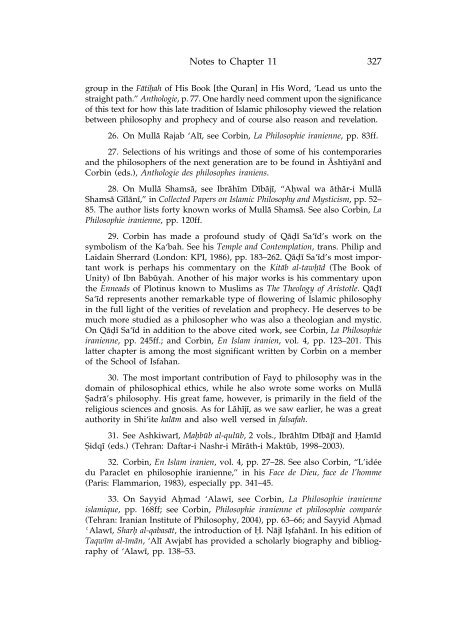Islamic Philosophy from Its Origin to the Present: Philosophy in the ...
Islamic Philosophy from Its Origin to the Present: Philosophy in the ...
Islamic Philosophy from Its Origin to the Present: Philosophy in the ...
You also want an ePaper? Increase the reach of your titles
YUMPU automatically turns print PDFs into web optimized ePapers that Google loves.
Notes <strong>to</strong> Chapter 11 327<br />
group <strong>in</strong> <strong>the</strong> Fåti÷ah of His Book [<strong>the</strong> Quran] <strong>in</strong> His Word, ‘Lead us un<strong>to</strong> <strong>the</strong><br />
straight path.” Anthologie, p. 77. One hardly need comment upon <strong>the</strong> significance<br />
of this text for how this late tradition of <strong>Islamic</strong> philosophy viewed <strong>the</strong> relation<br />
between philosophy and prophecy and of course also reason and revelation.<br />
26. On Mullå Rajab ‘Al¥, see Corb<strong>in</strong>, La Philosophie iranienne, pp. 83ff.<br />
27. Selections of his writ<strong>in</strong>gs and those of some of his contemporaries<br />
and <strong>the</strong> philosophers of <strong>the</strong> next generation are <strong>to</strong> be found <strong>in</strong> ≈shtiyån¥ and<br />
Corb<strong>in</strong> (eds.), Anthologie des philosophes iraniens.<br />
28. On Mullå Shamså, see Ibråh¥m D¥båj¥, “A±wal wa åthår-i Mullå<br />
Shamså G¥lån¥,” <strong>in</strong> Collected Papers on <strong>Islamic</strong> <strong>Philosophy</strong> and Mysticism, pp. 52–<br />
85. The author lists forty known works of Mullå Shamså. See also Corb<strong>in</strong>, La<br />
Philosophie iranienne, pp. 120ff.<br />
29. Corb<strong>in</strong> has made a profound study of Qå∂¥ Sa‘¥d’s work on <strong>the</strong><br />
symbolism of <strong>the</strong> Ka‘bah. See his Temple and Contemplation, trans. Philip and<br />
Laida<strong>in</strong> Sherrard (London: KPI, 1986), pp. 183–262. Qå∂¥ Sa‘¥d’s most important<br />
work is perhaps his commentary on <strong>the</strong> Kitåb al-taw÷¥d (The Book of<br />
Unity) of Ibn Bab¨yah. Ano<strong>the</strong>r of his major works is his commentary upon<br />
<strong>the</strong> Enneads of Plot<strong>in</strong>us known <strong>to</strong> Muslims as The Theology of Aris<strong>to</strong>tle. Qå∂¥<br />
Sa‘¥d represents ano<strong>the</strong>r remarkable type of flower<strong>in</strong>g of <strong>Islamic</strong> philosophy<br />
<strong>in</strong> <strong>the</strong> full light of <strong>the</strong> verities of revelation and prophecy. He deserves <strong>to</strong> be<br />
much more studied as a philosopher who was also a <strong>the</strong>ologian and mystic.<br />
On Qå∂¥ Sa‘¥d <strong>in</strong> addition <strong>to</strong> <strong>the</strong> above cited work, see Corb<strong>in</strong>, La Philosophie<br />
iranienne, pp. 245ff.; and Corb<strong>in</strong>, En Islam iranien, vol. 4, pp. 123–201. This<br />
latter chapter is among <strong>the</strong> most significant written by Corb<strong>in</strong> on a member<br />
of <strong>the</strong> School of Isfahan.<br />
30. The most important contribution of Fay∂ <strong>to</strong> philosophy was <strong>in</strong> <strong>the</strong><br />
doma<strong>in</strong> of philosophical ethics, while he also wrote some works on Mullå<br />
|adrå’s philosophy. His great fame, however, is primarily <strong>in</strong> <strong>the</strong> field of <strong>the</strong><br />
religious sciences and gnosis. As for Låh¥j¥, as we saw earlier, he was a great<br />
authority <strong>in</strong> Shi‘ite kalåm and also well versed <strong>in</strong> falsafah.<br />
31. See Ashkiwar¥, Ma÷b¶b al-qul¶b, 2 vols., Ibråh¥m D¥båj¥ and ¡am¥d<br />
|idq¥ (eds.) (Tehran: Daftar-i Nashr-i M¥råth-i Makt¨b, 1998–2003).<br />
32. Corb<strong>in</strong>, En Islam iranien, vol. 4, pp. 27–28. See also Corb<strong>in</strong>, “L’idée<br />
du Paraclet en philosophie iranienne,” <strong>in</strong> his Face de Dieu, face de l’homme<br />
(Paris: Flammarion, 1983), especially pp. 341–45.<br />
33. On Sayyid A±mad ‘Alaw¥, see Corb<strong>in</strong>, La Philosophie iranienne<br />
islamique, pp. 168ff; see Corb<strong>in</strong>, Philosophie iranienne et philosophie comparée<br />
(Tehran: Iranian Institute of <strong>Philosophy</strong>, 2004), pp. 63–66; and Sayyid A±mad<br />
˜Alaw¥, Shar÷ al-qabasåt, <strong>the</strong> <strong>in</strong>troduction of ¡. Nåj¥ I∑fahån¥. In his edition of<br />
Taqw¥m al-¥mån, ‘Al¥ Awjab¥ has provided a scholarly biography and bibliography<br />
of ‘Alaw¥, pp. 138–53.

















